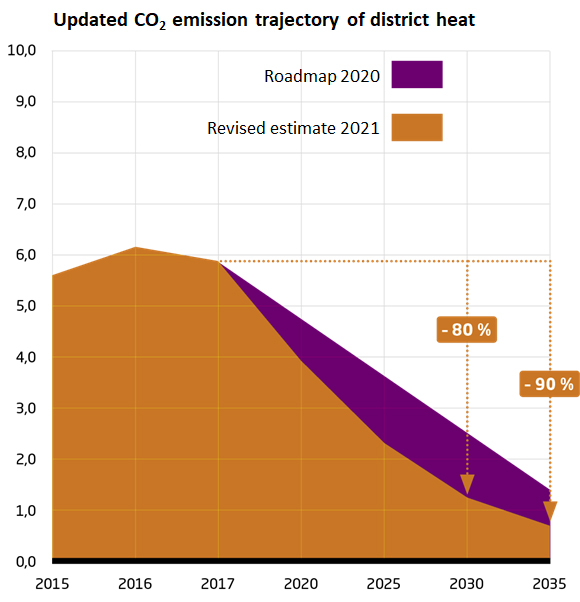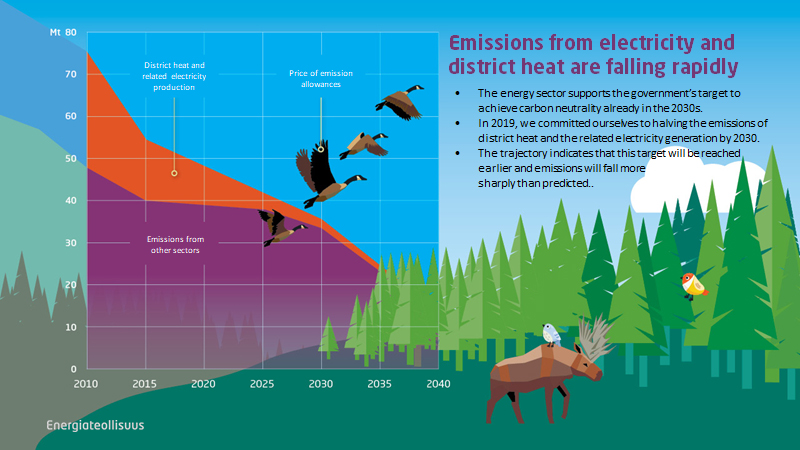Low-carbon roadmap
The roadmap estimates how demand for electricity, heat and gas will evolve. Finland’s road to a low-carbon future is based on clean energy, secure networks and a functioning energy market. Electricity, heat and gas networks and a flexible market are the basis for the functioning of a new, clean energy system.
Emissions from electricity and district heat are falling rapidly
The energy sector supports the target to achieve carbon neutrality in the 2030s. The trajectory of the 2021 updated roadmap shows that emissions are falling more sharply than previously anticipated and the sector is getting closer to achieving carbon neutrality. The first update of the Low Carbon Roadmap was published in May 2021, less than a year after the Roadmap was published.

The Low Carbon Roadmap assesses the development of demand for electricity, heat and gas. The Roadmap is a vision of the scale of change, the consequences and the conditions to meet the climate challenge.
Finland is carbon neutral when emissions and sinks are in balance. Forests are Finland’s most important carbon sink, but technological carbon sinks are becoming increasingly important. Carbon neutrality is achieved by reducing emissions and increasing carbon sinks. Both means must be in place to achieve the goal of Finland as a carbon neutral society by 2035.

Carbon-neutral society is created in cooperation with the energy sector and the decision-makers
- EU must set clear emissions reduction targets for 2040 and 2050.
- Development and expansion of emissions trading is the most important climate policy instrument.
- A roadmap for energy taxation shall be drawn up to remove energy taxes and tax structures that impede the reduction of emissions.
- Society’s contributions must be focused on research and product development.
Energy as a solution
A carbon-neutral society is based on practical solutions implemented by energy companies.
- Energy transition is already underway and investments in the field are directed at clean production. The energy sector is implementing the change together with other industries and customers. The actions of energy companies reduce carbon emissions of industry, transport, the heating of buildings, services, and agriculture.
- Finland’s road to a low-carbon future is based on clean energy, secure networks and a functioning energy market. Electricity, heat and gas networks and a flexible market are the basis for the functioning of a new, clean energy system.
- Circular economy is based on cross-sector cooperation, from which all benefit. Sidestreams of agriculture and forestry, as well as waste and excess heat are turned into energy. At the same time, circular economy is enabled by clean energy.
- The competitiveness of Finnish production is based on secure and cost-effective energy. Responsibility in the energy sector means that we take care of society’s operational capacity on the way to carbon neutrality.
Low-carbon roadmap for the energy sector
Low-carbon roadmap for the energy sector
The Low-carbon roadmap for the energy sector estimates how demand for electricity, heat and gas will evolve. Finland’s road to a low-carbon future is based on clean energy, secure networks and a functioning energy market. Electricity, heat and gas networks and a flexible market are the basis for the functioning of a new, clean energy system.

Our experts on this topic

Climate policy, emission trading system (EU ETS)

electricity production climate policy